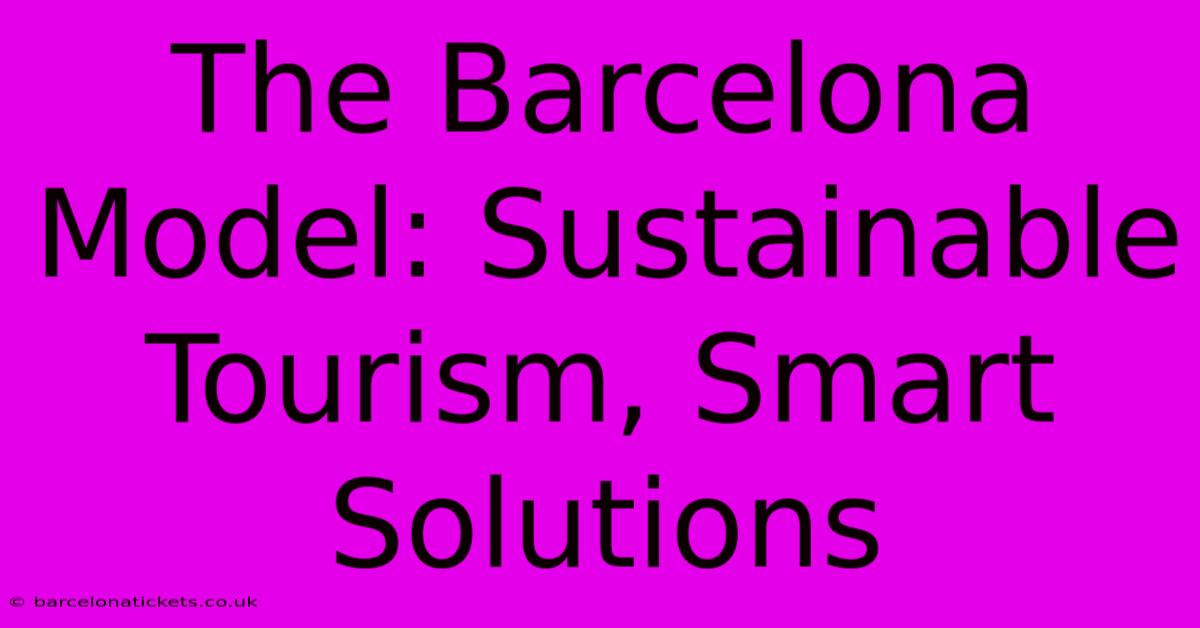The Barcelona Model: Sustainable Tourism, Smart Solutions

Table of Contents
The Barcelona Model: Sustainable Tourism, Smart Solutions
Barcelona, a city renowned for its vibrant culture, stunning architecture, and delicious cuisine, has also become a case study in navigating the challenges and opportunities presented by mass tourism. The "Barcelona Model," though not a formally defined plan, represents the city's evolving approach to managing tourism sustainably and intelligently. This approach blends innovative technology, citizen engagement, and a commitment to preserving the city's unique character. Let's delve into the key elements of this model and explore its successes and ongoing challenges.
Understanding the Challenges: From Boom to Bust
For years, Barcelona experienced an unprecedented tourism boom. While beneficial for the economy, this rapid growth brought significant downsides:
- Overtourism: Crowded streets, strained infrastructure, and a diminished quality of life for residents.
- Pricing Inflation: Increased costs of living, particularly in tourist-heavy areas, impacting affordability for locals.
- Environmental Strain: Increased waste generation, water consumption, and carbon emissions.
- Loss of Authenticity: The displacement of local businesses and the homogenization of the city's cultural landscape.
The Pillars of the Barcelona Model: Smart Solutions for Sustainable Tourism
Barcelona's response to these challenges has been multifaceted, focusing on several key pillars:
1. Smart City Technologies: Monitoring and Management
Barcelona has embraced smart city technologies to monitor and manage tourism flow. This includes:
- Real-time data analytics: Tracking visitor numbers in specific areas to identify overcrowding and adjust strategies accordingly.
- Smart sensors: Monitoring environmental indicators like air quality and noise pollution to inform policy decisions.
- Mobile apps: Providing tourists with information on attractions, transportation, and less crowded alternatives.
2. Decentralizing Tourism: Diversifying Experiences
The city is actively working to diversify its tourism offering, encouraging visitors to explore beyond the traditional hotspots:
- Promoting lesser-known neighborhoods: Showcasing the authentic character of different districts.
- Supporting local businesses: Encouraging tourists to patronize independent shops, restaurants, and cultural venues.
- Developing niche tourism products: Catering to specific interests like gastronomy, architecture, or sustainable travel.
3. Citizen Participation: Ensuring Local Wellbeing
Barcelona recognizes the crucial role of residents in shaping its tourism strategy. This involves:
- Community engagement initiatives: Creating platforms for residents to voice their concerns and participate in decision-making processes.
- Protecting residential areas: Implementing measures to mitigate the negative impacts of tourism on local neighborhoods.
- Balancing economic benefits with community well-being: Ensuring that the economic advantages of tourism are shared equitably.
4. Environmental Sustainability: Minimizing the Footprint
Environmental consciousness is central to Barcelona's approach. Efforts include:
- Promoting sustainable transportation: Encouraging the use of public transport, cycling, and walking.
- Reducing waste generation: Implementing waste management programs and promoting eco-friendly practices among businesses and tourists.
- Conserving resources: Reducing water consumption and minimizing energy usage in tourist facilities.
Ongoing Challenges and Future Directions
Despite significant progress, Barcelona continues to face challenges:
- Balancing economic growth with sustainability: Finding the optimal balance between tourism revenue and the preservation of the city's quality of life.
- Enforcing regulations effectively: Ensuring that tourism businesses comply with sustainability standards.
- Adapting to evolving tourist behavior: Responding to shifting preferences and trends in the tourism sector.
The Barcelona Model is a work in progress. It requires constant adaptation and innovation to remain effective. However, its emphasis on smart solutions, citizen participation, and environmental sustainability provides a valuable framework for other cities grappling with the complexities of managing tourism responsibly. By prioritizing the well-being of its residents while striving for economic prosperity, Barcelona continues to serve as a crucial example for urban planning and sustainable tourism development globally. The future success of this model depends on continuous collaboration, data-driven decision making and a commitment to long-term planning.

Thank you for visiting our website wich cover about The Barcelona Model: Sustainable Tourism, Smart Solutions. We hope the information provided has been useful to you. Feel free to contact us if you have any questions or need further assistance. See you next time and dont miss to bookmark.
Featured Posts
-
Barcelona 22 23 Away The Perfect Addition
Mar 28, 2025
-
The Ronaldo Barcelona Rivalry Goal By Goal
Mar 28, 2025
-
Barcelonas Shopping Streets Printable Map
Mar 28, 2025
-
Olympic Village Barcelona Your Gateway To Barcelona
Mar 28, 2025
-
Barcelona 22 23 The Official Club Kit
Mar 28, 2025
